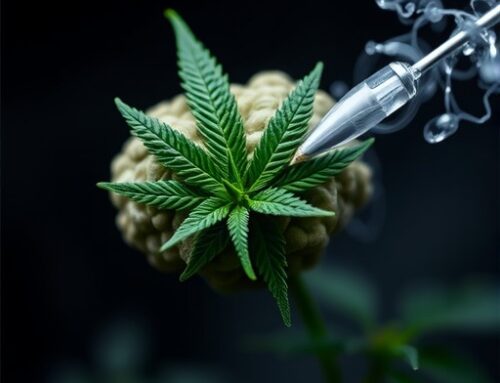Tobacco and Cannabis Together Alter Brain’s “Bliss Molecule” System
October 21, 2025
Summary: People who use both cannabis and tobacco show unique brain chemistry linked to higher anxiety, depression, and difficulty quitting. Brain scans revealed increased levels of FAAH, an enzyme that breaks down the brain’s “bliss molecule,” anandamide.
This imbalance means less natural mood regulation and greater vulnerability to stress and relapse. The findings uncover a potential biological target for treating cannabis use disorder, especially in those who co-use tobacco.
Key Facts:
- Distinct Brain Pattern: Co-use of cannabis and tobacco increased FAAH levels, reducing the “bliss molecule” anandamide.
- Mental Health Link: The imbalance may explain higher anxiety, depression, and relapse risk among co-users.
- Treatment Implications: Identifying this mechanism could guide the development of targeted medications for cannabis use disorder.
Source: McGill University
People who use both cannabis and tobacco show distinct brain changes compared to those who use cannabis alone, according to a new study led by McGill University researchers at the Douglas Research Centre.
The finding may help explain why people who use both cannabis and tobacco often report increased depression and anxiety, and why quitting cannabis is harder for them than for people only using cannabis
“This is the first evidence in humans of a molecular mechanism that may underlie why people who use both cannabis and tobacco experience worse outcomes,” said lead author Rachel Rabin, Associate Professor in McGill’s Department of Psychiatry and researcher at the Douglas.
“Identifying this mechanism is an important step toward finding targets for future medications to treat cannabis use disorder, especially among those that co-use tobacco. Right now, the only available treatments are behavioural therapies such as counselling,” she said.
In Canada, about one in 20 people who used cannabis in the past year are considered at risk for cannabis use disorder. That figure rises to one in three among people who use it more frequently.
While tobacco-smoking rates are declining overall, most people who use cannabis also use tobacco, the researchers note. Most studies have looked at cannabis and tobacco in isolation, Rabin added, leaving a gap that this preliminary study begins to address.
Shifts in brain’s ‘bliss molecule’
PET brain scans revealed that people who used both tobacco and cannabis had higher levels of FAAH, relative to people who only used cannabis. FAAH is the enzyme that breaks down anandamide, a naturally occurring molecule sometimes called the “bliss molecule” for its role in mood and stress regulation. More FAAH means less anandamide, a pattern previously linked to anxiety, depression and relapse when trying to quit cannabis.
Researchers analyzed scans from 13 young adults. Eight smoked only cannabis, while five also smoked cigarettes daily. Cannabis users averaged just over one gram per day, while cigarette use ranged from one to 12 per day.
Because the data was originally collected for another study, the research did not include a tobacco-only group. So it’s possible tobacco alone caused the changes. However, the researchers say the results suggest something more is at play.
“What surprised us was how strong the effect was, and how different it was from those who only used cannabis, compared to those who used both tobacco and cannabis,” said co-author Romina Mizrahi, Professor of Psychiatry and director of the McGill Research Centre for Cannabis.
The researchers are now recruiting people who smoke cigarettes and people who vape nicotine in a new study to test whether the same brain changes occur without cannabis.
About the study
Funding: The study received funding form the National Institute of Mental Health.
Key Questions Answered:
A: People who use both cannabis and tobacco show higher levels of FAAH, an enzyme that breaks down anandamide, which is linked to mood regulation and addiction resilience.
A: The altered brain chemistry could explain why co-users often face greater mental health challenges and find it harder to quit cannabis.
A: Scientists are now testing whether similar brain changes occur in people who smoke or vape nicotine without cannabis, to isolate the mechanism.
About this neuroscience research news
Author: Keila DePape
Source: McGill University
Contact: Keila DePape – McGill University
Image: The image is credited to Neuroscience News
Original Research: Open access.
“A preliminary investigation of tobacco co-use on endocannabinoid activity in people with cannabis use” by Rachel Rabin et al. Drug and Alcohol Dependence Reports
Abstract
A preliminary investigation of tobacco co-use on endocannabinoid activity in people with cannabis use
Tobacco is commonly co-used with cannabis. This is unfortunate because tobacco co-use exacerbates select clinical consequences associated with cannabis use.
Evidence demonstrates that low levels of anandamide, a prominent endocannabinoid, correlate with worse clinical outcomes.
Fatty acid amide hydrolase (FAAH) degrades anandamide, and greater FAAH levels may underlie poorer clinical outcomes in people who co-use relative to those who use only cannabis.
Therefore, we tested whether tobacco co-use increases FAAH levels beyond those associated with cannabis use alone.
Cannabis-using participants (N = 13) were parsed into individuals with daily tobacco use (CT, n = 5) and no current tobacco use (CAN, n = 8).
We evaluated group differences in FAAH, quantified using positron emission tomography and [11C]CURB, while controlling for sex and FAAH genotype in the prefrontal cortex, hippocampus, thalamus, sensorimotor striatum, substantia nigra, and cerebellum. A significant group x ROI interaction for [11C]CURB λk3 [F(5, 45)= 3.15, p = 0.016] emerged.
Bonferroni-corrected post-hoc tests indicated greater FAAH levels in CT compared to CAN in the substantia nigra (p = 0.023, d=1.54) and cerebellum (p = 0.003, d=1.76), while a trend emerged in the sensorimotor striatum (p = 0.054, d=1.33).
Preliminary findings suggest that tobacco co-use is associated with elevated FAAH activity relative to cannabis-only use, which may underlie poorer clinical outcomes associated with co-use.
Search
RECENT PRESS RELEASES
Related Post



